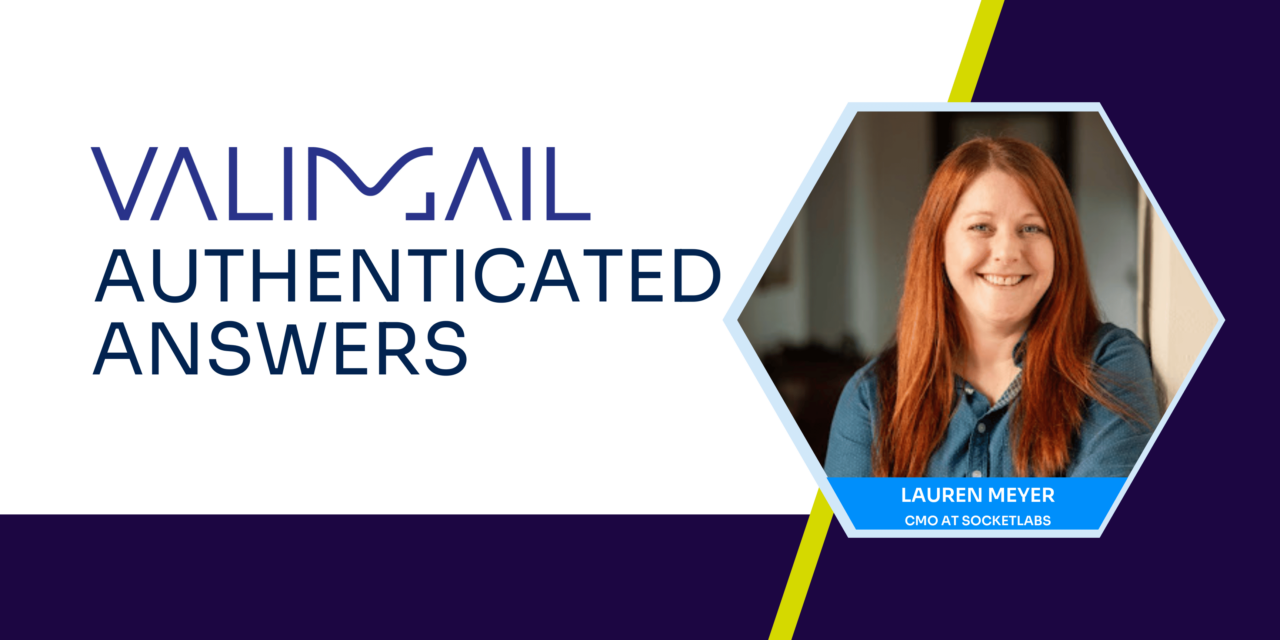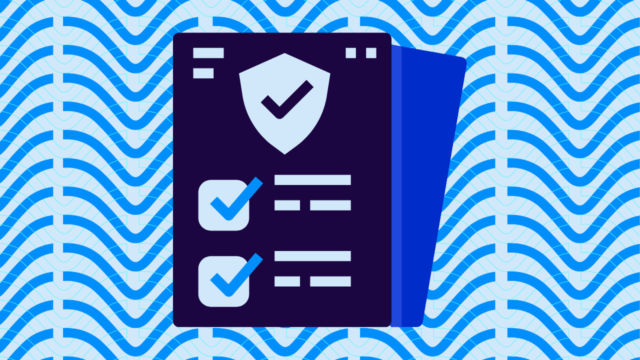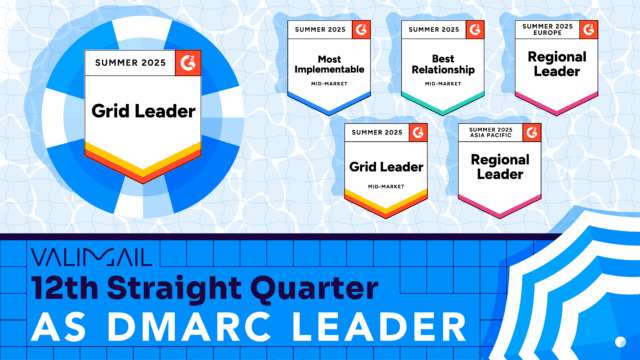Join us today with another interview in our blog series: Authenticated Answers! We sat down with Lauren Meyer, the Chief Marketing Officer at SocketLabs.
At Valimail, we take our work seriously but try not to take ourselves too seriously. This value inspires us to get to the heart of what makes people unique and how it affects their careers to provide valuable advice, inspiration, and insights to people working with email daily.
In this lighthearted interview series, we connect with experts from the email, IT, security, ISP, and authentication spaces to learn more about them and their experiences.
About Lauren Meyer

Lauren brings seventeen years of experience in the email industry to her role as Chief Marketing Officer for SocketLabs. Throughout her career, Lauren has helped small and large-scale senders get the most out of their email marketing programs, working with various ESPs and email technologies.
Having focused mainly on deliverability, anti-abuse, and compliance, Lauren is a vocal advocate for having a proactive, data-driven approach to email best practices and deliverability monitoring to improve the recipient experience and find more opportunities for email success.
When she’s not out saving the email world, she loves exploring the world, searching for new experiences and the next great slice of pizza. Many of those adventures happened locally with her wife and five-year-old twins since they moved from NYC to California.
How do you stay motivated when learning something challenging or frustrating?
I’m very curious by nature, but I tend to get frustrated very easily — usually with myself. I’ve found that having kids has really helped me with this because I constantly get to watch first-hand while they attempt to do something for the very first time.
Sometimes, they accomplish their goal right away. Other times, they struggle, just like the rest of us, and they get frustrated, just like the rest of us. But wouldn’t you know it, before long, they’ve figured it out… they can easily do that thing that was so tough for them just a few minutes, hours, days, or months prior.
So, when I’m feeling frustrated, I try to channel that energy and remember that I can eventually overcome whatever challenge I’m faced with. I just need to take a few breaths and give myself the time and space I need to figure it out…or you know, maybe just not be afraid to ask for some help from my peers.
What was the last wall you crashed through?
My transition from being an email deliverability and anti-abuse practitioner to a proper marketer at SocketLabs has been the toughest wall I’ve had to crash through…over and over (and over) again, particularly since we’ve just launched a new product.
Why? Well, if you thought deliverability had a lot of gray areas, I’d like to welcome you to the magical land of Marketing, where everything is subjective and just about everyone has a handful of “great ideas” to share.
Don’t get me wrong, some of those ideas are genuinely great! Others? Not so much. Maintaining a healthy balance can be challenging when you have feedback and suggestions coming at you from all angles.
I’m happy to report all those walls I’ve crashed into (and sometimes through!) have helped me learn to trust myself more and stress less. Major shout-out to Nicky Copland, marketing extraordinaire, for helping me get there!
What’s your favorite way to show gratitude?
Paying it forward. One of the fastest and smartest ways to research and solve our email problems is to discuss insights and ideas with peers in real-time. Yet, not everybody has had the opportunity to attend conferences like M3AAWG, CSA Summit, Email Evolution Conference, and the various Inbox Expo and Deliverability events organized by Andrew and Nely Bonar, just to name a few.
And they may not have been fortunate enough to have incredibly patient folks holding their hands early on in their careers like I did. (Another shout-out, this time to John Stephenson, for patiently walking me through the forest of foundational-yet-brain-busting concepts within email all those many moons ago. )
As a result, I’ve been attempting to give back to the email community in a couple of different ways, such as sharing educational content on LinkedIn and the SocketLabs blog and running virtual roundtable events where email marketing, product, and deliverability practitioners come together once per month to discuss real-life challenges they’re facing right now, to see if we can solve those email ice cream headaches together.
I’ve also been hosting monthly(ish) career conversations where folks from across the industry come together — right on LinkedIn — to engage in informal discussions on topics such as advocating for yourself, your team, or email, whether the managerial path is right for you, transitioning from individual contributor (IC) to manager, speaking the language of business, stress management, preventing burnout, and more.
Lastly, we’ve spun up a mentorship program at SocketLabs! Working on getting the first cohort paired up, but I’m also toying with ways we can make the traditional mentorship model a bit more fun — perhaps with informal mixers where you get to spend time with a few different folks vs a longer-term engagement one-on-one. TBD, I guess. If you wanna get involved as either a mentor or mentee, please contact me! You can do both. Careers within email are a never-ending journey, after all.
What’s the funniest mistake you’ve made, and how’d you handle it?
I used to work at a soccer shop when I was in high school. My hours were 5-9 p.m. after school, and I usually closed up by myself. One night, I decided to wear my brother’s watch (found in the car), which hadn’t yet been set to account for daylight savings time, so I ended up closing the store 1 hour early. My gut was telling me something felt wrong, but I didn’t know how to read it at the time…until the self-locking back door to the shop closed behind me.
I was admittedly too hard on myself for the mistake, but when I called the owner, mortified, he just laughed and chalked it up to me being a 16-year-old with a low-impact gig, which allowed me to stop feeling like a total bonehead. My takeaway was that people make mistakes, and that’s ok. Much like within email, we were not saving lives!
What’s the smallest hill you are willing to die on?
The toilet paper roll should be hung facing over the top! According to science, I’m correct…or at least the article I found online says so. Super factual evidence, clearly.
I will spare you the details on why I’m right, but you can find them here if you feel the need to disagree with this obviously correct day of doing things. If you’re still not convinced, bring it on. I’ll see you on top of TP Hill at high noon, weapon of choice in hand.
Within email, I’d say, “Don’t send cold emails,” although I don’t think this is a small hill at all. Getting permission before sending is super important for deliverability, and it’s also a keystone for building a positive relationship with the folks you’re sending emails to. Nothing makes a bad first impression like irrelevant spam.
What do you think is the biggest challenge in deliverability, and what solution would you recommend to overcome it?
Getting your clients to act! Deliverability people tend to spend a good portion of their lives digging through the weeds to find out what’s going on — after the proverbial Titanic has already hit the iceberg — and then they spend the rest of their time explaining why customers need to improve their list collection, expectation-setting, segmentation, bounce management, reputation management, you name it. We talk about implementing best practices until we are quite literally blue in the face.

The answer is right there in front of senders. It’s in the data. It’s in their email recipients’ reactions (or lack thereof). It’s in the meeting notes from their calls with their technical account managers and the deliverability folks behind the scenes.
But some companies plug along anyway, not making the required changes to avoid a(nother) crash, slowly chipping away at their sender reputation. It’s like they’ve got a shoelace that’s been slowly becoming untied for years, yet they’re surprised when they eventually tripped over it.
Without email reporting that makes it easy to quickly identify, diagnose, and explain what’s going on to decision-makers in a way that inspires action, senders are doomed to keep getting the lackluster deliverability they deserve.
What are your thoughts on the new Google/Yahoo email requirements for 2024?
It feels like every year; at least one semi-big change on the mailbox provider side gets everybody’s feathers ruffled. Last year, opens were the talk of the town when Apple’s Mail Privacy Protection (MPP) brought to light the fact that opens are not all that accurate, never have been…and would be even less accurate once MPP kicked in.
This year, senders have spent a lot of time preparing (er, freaking out??) about the new sender requirements that Gmail and Yahoo started rolling out in February 2024.

Reminds me very much of the Y2K panic…if you’re old enough to have lived through it, you might remember how many people legitimately thought the world as we knew it was about to end. But it didn’t! Yes, some folks had to scramble to get their systems ready to transition from the 1900s to the 2000s. But in the end, everything was fine.
Ultimately, this progression is just one of many that email folks have endured to make email a safer, more enjoyable experience for everyone involved. Gmail and Yahoo are in the spotlight because they’ve nailed these requirements to the wall, but they will not be the last to do so. Respecting privacy and making email more secure is top of mind for most of us in the industry — regardless of whether you’re a sender or a receiver.
The good news? Most of these “new” requirements have been recommended as best practices for years, so most legitimate senders are already compliant. As a result, they’re either seeing no changes in performance, or they’ve actually seen a nice little lift.
The ones who are struggling are folks who’ve been flying under the radar with shared IPs and domains up until now, allowing them to benefit from the positive sender reputation of others. Once they get themselves authenticated, mailbox providers can more clearly identify them and filter them to the spam folder accordingly. It’s time for these senders to finally leap over to the good side of email.
How would you explain DMARC to your grandparents, friends, or relatives?
I wouldn’t? Jk…sort of. There’s a lot of nuance to implementing DMARC and just as many technical terms and concepts to be aware of. So, if we’re talking about getting my relatives to implement DMARC, I’d run for the hills.
When explaining DMARC, I usually say it’s like Caller ID for emails. It helps you identify who sent the email and whether it’s coming from someone you trust or a potential scammer — similar to how caller ID helps you recognize who’s calling you on the phone.
When attempting to explain how mailbox providers handle policy enforcement, I’ve found success (and a few laughs) in comparing DMARC to parents leaving their children with their grandparents for a few hours. Most parents have a set of rules they try very hard to stick to to avoid chaos at the drop of a hat. IYKYK.
But all that policy-setting you did around bedtimes, eating dessert before dinner, and limiting TV time goes out the window when you leave your kids with their grandparents.
Sometimes, they don’t know the rules. Other times, they know the rules — they’re written on that note you always leave on the fridge — but they decide in that moment they will take a different direction. They know what’s best for their grandkids! Mailbox providers can sometimes operate similarly, overriding the DMARC policy that’s been set when they believe the email is something their users would want to receive.




